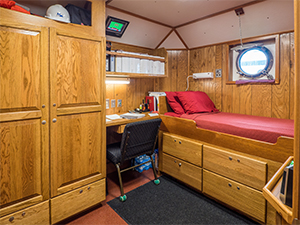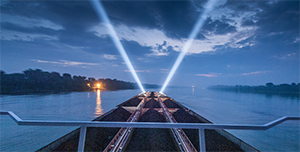An industry-backed study says the current work hour system on tugboats and towboats doesn’t need to be changed, but mariners and sleep experts would like to see better fatigue management and hours-of-service regulations.
With the impending announcement of 46 CFR Subchapter M, which will establish an inspection regime for towing vessels, the American Waterways Operators (AWO) is lobbying for no changes to the current work hour rules.
In February, the Transportation Research Board of the National Academies of Sciences, Engineering and Medicine released a study concluding that there is no scientific data to support work hour changes for towing vessel crewmembers.
The study’s authors indicated that the square watch system currently in use on many towing vessels — six hours on duty followed by six hours off, twice a day — provides adequate rest so that “performance is comparable, and in some cases, better than when the same duration of sleep is obtained in a single sleep period.”
Jennifer Carpenter, AWO executive vice president and chief operating officer, said the organization plans to discuss the results of the study with the Coast Guard. The AWO’s perspective is that rather than mandate a change in work hours, such as a system of eight hours on/16 hours off, the better alternative is to develop fatigue risk management programs to ensure adequate rest under the current system.
“One of the things we’ve found, and this study supports this, is the current hours of service requirements for towing vessel operators are not a barrier to getting the amount of sleep you need within a 24-hour period,” Carpenter said.
However, mariners may not agree. Capt. Joseph Dady, a veteran tugboat captain and former president of the defunct National Mariners Association who also served on the Coast Guard Towing Safety Advisory Committee, has worked the square watch for much of his 36-year career. Dady works two weeks on/two weeks off as captain of a tug with a four-person crew plying the waters in and around New York Harbor.
“To me, the study was self-serving and biased. Their issue is whether the Coast Guard will deal with fatigue and manning in Subchapter M,” Dady said. “To me, crewing — the amount of men on the boat doing the work — is the problem more than anything.”
The study cites laboratory data suggesting that sleep can be obtained in more than one sleep period, referred to as anchor sleep/nap sleep. As long as the total duration is seven to eight hours, performance is comparable between a single sleep period and two separate sleep periods. Rather than expanding the amount of time allowed for sleep, the industry wants to focus on the quality of sleep.
“If you’re looking at the amount of time in bed that towing vessel captains and pilots are getting, it is sufficient, but how much of that time are they sleeping? That’s where we have what the scientists call a sleep efficiency gap, and so that’s what we’re hoping to close,” Carpenter said.
Creating a safety-focused company culture that includes fatigue management is the best long-term solution, according to Dr. Nathaniel Watson, president of the American Academy of Sleep Medicine (AASM) and a board-certified physician in sleep medicine and neurology. Watson is a professor of neurology at the University of Washington in Seattle, co-director of the university’s Sleep Center and director of the Harborview Medical Center Sleep Clinic.
“The contribution of fatigue to transportation accidents is vastly underestimated and it’s been only recently that various industries are starting to pay attention to this issue, not only from a safety standpoint but also from an economic standpoint,” Watson said. “It’s clear that fatigue-related accidents injure not only people but also cost the involved corporations millions of dollars.”
While the off-duty time available for sleep is important, it’s only one part of the fatigue management equation. Timing and quality of sleep are important as well.
“You might have a lot of noise, sometimes there are sea conditions that keep you awake, and you don’t get that full sleep that you need,” Dady said. “Your body wants eight hours of sleep in order to function correctly, and when you work six on and six off it’s impossible to do that.”
 |
|
An engineer’s stateroom inside a tugboat recently built at Eastern Shipbuilding in Panama City, Fla. |
|
Brian Gauvin |
Even with six hours off in which to sleep, actually getting to sleep quickly, or being able to doze off in the afternoons is challenging.
“If I’m relieved at midnight, by the time I get to bed it’s maybe 12:30 and I have to get up at 5, so you get maybe five hours of sleep,” Dady said. “The problem with the six-on-and-six-off system is that the sleeping pattern isn’t a healthy sleeping pattern.”
Dady recalled a recent trip when he was awake for 18 consecutive hours due to conditions on the vessel, a situation allowable under the work-hours’ exception to the 12-hour rule for “special conditions.” A mariner could find himself in a sleep deficit due to factors beyond his control.
“In that situation you never get that power sleep you need to recharge your batteries. You get fatigued and it takes days to catch up,” Dady said.
Watson, the sleep expert, agrees that the maritime industry’s traditional schedule does not provide adequate opportunity for sleep.
“If you look at it like a shift work schedule, clearly six hours is not going to be adequate to allow an individual to sleep the seven or more hours that we know that adults need on a nightly basis in order to support optimal health and performance,” Watson said. “The maritime industry focuses on the anchor-sleep/nap-sleep strategy and that’s a reasonable strategy, but the problem is, even if you give operators the opportunity to sleep, is doesn’t necessarily mean they’re using it to sleep.”
Watson noted the study showed that while individuals may be getting at least 12 hours in which they could obtain their sleep, “they are not getting anywhere near the amount of sleep they need to be safe. So the question really is, how do we as a community help these operators get the sleep they need?”
Watson advocates for the cultural approach as well, with a fatigue management program looking at all aspects of the issue, not just time off. Good sleep requires not only adequate duration but also appropriate timing, consistency of timing on a day-to-day or night-to-night basis, and an absence of sleep disorders.
Other sectors of the transportation industry, such as highway and rail carriers, are moving to address the problem of sleep disorders. Even if an individual has the proper time and environment in which to sleep, a sleep disorder could prevent adequate rest. Watson called obstructive sleep apnea one of the most common disorders in the world, and about 75 percent of the people who have it are undiagnosed or untreated.
“If you have a corporation that embraces fatigue management, part of that program would be evaluating the mariners for sleep disorders and getting those treated as well,” Watson said.
The pay structure for mariners works against adding crewmembers to the rotation to allow for longer rest periods, Dady noted.
“The way it’s structured today you get paid the same amount no matter how many hours you work, so there’s no motivation for them to change the work hours because the pay is the same,” Dady said. “The company argues that you would have to put another crew on the boat, and everyone would get paid less.”
Unfortunately, it seems to come down to simple numbers for mariners.
“If you ask me the simple question, do I think an eight-hour watch is safer than the six-hour watch, absolutely without question it is, but getting (the owners) to change it, that’s the fight,” Dady said.

